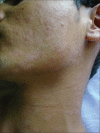Pityriasis Rosea: Clinical Profile from Central India
- PMID: 30505781
- PMCID: PMC6232983
- DOI: 10.4103/idoj.IDOJ_12_18
Pityriasis Rosea: Clinical Profile from Central India
Abstract
Background: Pityriasis rosea (PR) is a common, self-limiting dermatologic disorder. The information regarding the clinical profile of the disease in India is limited because of inadequate studies.
Materials and methods: A retrospective, record-based study on the clinical presentation of PR was conducted in a tertiary care center based in Central India. Data of all the patients presenting to our outpatient department from October 2014 to March 2015 with a clinical diagnosis of PR were analyzed.
Results: The age of the patients ranged from 9 to 54 (mean-20.32) years. There was a male preponderance with a male-to-female ratio of 1.3:1. History of prodromal symptoms was present in 11 (27.5%) patients. Pruritus was a common symptom in 30 of 40 (75%) patients. Of 40 patients, 15 (35%) had herald patch. The morphology of skin lesions was typical in most of the patients (77.5%). Two (5%) patients had papular skin lesions, four (10%) patients had erythema multiforme-like skin lesions, and one patient each had papulovesicular, psoriasiform, and eczematous skin lesions.
Conclusion: The clinical features of most of the cases were mostly in accordance with the classical pattern of PR, with few unusual features.
Keywords: Epidemiology; India; pityriasis rosea.
Conflict of interest statement
There are no conflicts of interest.
Figures




References
-
- Tay YK, Goh CL. One year review of pityriasis rosea at the National Skin Centre, Singapore. Ann Acad Med Singapore. 1999;28:829–31. - PubMed
-
- Chuang TY, Ilstrup DM, Perry HO, Kurland LT. Pityriasis rosea in Rochester, Minnesota: 1969 to 1978. J Am Acad Dermatol. 1982;7:80–9. - PubMed
-
- Ganguly S. A clinicoepidemiological study of pityriasis rosea in South India. Skinmed. 2013;11:141–6. - PubMed
-
- Truhan AP. Pityriasis rosea. Am Fam Physician. 1984;29:193–6. - PubMed
LinkOut - more resources
Full Text Sources
Research Materials

